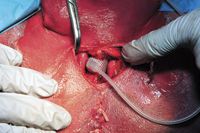Article
Cadaveric model feasible for studying male stress urinary incontinence surgery
The mechanism of action is somewhat unclear for newer procedures to correct male stress urinary incontinence such as slings, but a new cadaveric model appears to offer valuable insight.
St. Petersburg, FL-The mechanism of action is somewhat unclear for newer procedures to correct male stress urinary incontinence such as slings, but a new cadaveric model appears to offer valuable insight, attendees at the Society for Urodynamics and Female Urology winter meeting learned.

"We wanted to develop a reproducible model to study these newer procedures," said first author Jaspreet Sandhu, MD, assistant professor of urology at Memorial Sloan-Kettering. "The model we came up with isn't based on established cadaveric models. It emulates Valsalva conditions and allows us to replicate the effects of surgery."
Three cadavers were used in the study, all of which had mean ALPP of 8.5 cm H2O. When a properly sized, deflated urethral cuff was in place, ALPP increased to 44.7 cm H2O. ALPP increased further to 77.8 cm H2O when urethral cuff pressure was 55 cm H2O.
Strong correlation between pressures
On the pig urethra model, ALPP was 18 cm H2O with an unpressurized cuff and 71.5 with the 55 cm H2O pressurized cuff. Change between the pressurized and unpressurized cuff was 33.1 cm H2O in the cadaver model and 53.2 cmH2O in the pig model.
"This model appears to be more physiologic than other models," said Dr. Jaffe. "We should be able to replicate any surgery performed for incontinence. We were also happy with the correlation between cuff pressure and leak point pressure."
Dr. Sandhu noted that the cadaver appears to offer similar results for the artificial urinary sphincters as those obtained through ex vivo models. He said his team plans to use the new model to test various products for treatment of male stress incontinence "so that we have useful information for practicing urologists."





